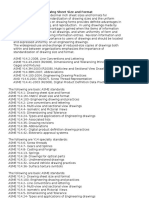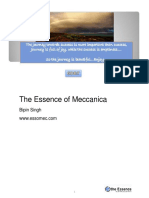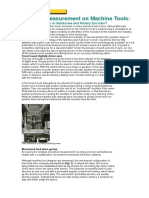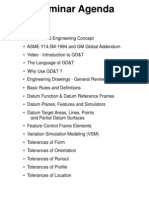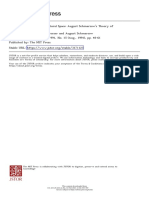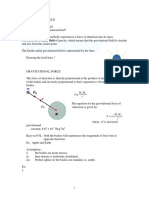Drawing Practices
Drawing Practices
Uploaded by
pverma02Copyright:
Available Formats
Drawing Practices
Drawing Practices
Uploaded by
pverma02Original Description:
Copyright
Available Formats
Share this document
Did you find this document useful?
Is this content inappropriate?
Copyright:
Available Formats
Drawing Practices
Drawing Practices
Uploaded by
pverma02Copyright:
Available Formats
Familiarization of Drawing
symbols and Drawing Reading
E. Kishore
2
A FEW BASIC ASPECTS
TYPES OF VIEWS
ANGLES OF PROJECTION
SURFACE ROUGHNESS SYMBOLS
DIMENSIONING & TOLERANCING
UNTOLERATED DIMENSIONS
3
TYPES OF VIEWS
1. ORTHOGRAPHIC PROJECTION
2. SECTION
3. DETAIL
4. AUXILIARY PROJECTION
4
5
6
7
ANGLES OF PROJECTION
FIRST ANGLE THIRD ANGLE
8
FIRST ANGLE PROJECTION
9
COMMON LINETYPES
Black = object line and hatching
Red = hidden line
Blue = center line
Magenta = phantom line or cutting plane
10
11
SURFACE ROUGHNESS SYMBOL
SURFACE OBTAINED BY ANY
PRODUCTION METHOD
12
13
THE UNIT OF SURFACE ROUGHNESS IS MICRONS.
14
DIMENSIONING AND TOLERANCING
Dimensioning specifications define the nominal, as-modeled
or as-intended geometry.
Tolerancing specifications define the allowable variation for
the form and possibly the size of individual features, and the
allowable variation in orientation and location between
features.
15
PARALLEL DIMENSIONING
Parallel dimensioning consists of several dimensions originating from one
projection line.
16
SUPERIMPOSED RUNNING DIMENSIONING
Superimposed running dimensioning simplifies parallel dimensions in order to reduce the
space used on a drawing. The common origin for the dimension lines is indicated by a small
circle at the intersection of the first dimension and the projection line. In general all other
dimension lines are broken.
17
CHAIN DIMENSIONING
Chains of dimension should only be used if the function of the object won't be
affected by the accumulation of the tolerances.
18
COMBINED DIMENSIONING
A combined dimension uses both chain and parallel dimensioning.
19
DIMENSIONING BY CO-ORDINATES
Two sets of superimposed running
dimensions running at right angles
can be used with any features
which need their centre points
defined, such as holes
It is also possible to simplify co-ordinate
dimensions by using a table to identify
features and positions
20
DIMENSIONING RADII
All radial dimensions are preceded by the capital R.
All dimension arrows and lines should be drawn perpendicular to the radius so that
the line passes through the centre of the arc.
All dimensions should only have one arrowhead which should point to the line being
dimensioned.
There are two methods for dimensioning radii.
(a) shows a radius dimensioned with the centre of the radius located on the
drawing.
(b) shows how to dimension radii which do not need their centres locating.
SPHERICAL DIMENSIONS
The radius of a spherical surface (i.e. the top of a drawing pin) when dimensioned
should have an SR before the size to indicate the type of surface.
21
DIMENSIONING HOLES
When dimensioning holes the method of manufacture is not specified unless they
necessary for the function of the product.
The word hole doesn't have to be added unless it is considered necessary.
The depth of the hole is usually indicated if it is isn't indicated on another view.
The depth of the hole refers to the depth of the cylindrical portion of the hole and not
the bit of the hole caused by the tip of the drill.
22
DIMENSIONING CIRCLES
All dimensions of circles are proceeded by this symbol phi . There are several
conventions used for dimensioning circles:
(a) shows two common methods of dimensioning a circle. One method
dimensions the circle between two lines projected from two diametrically
opposite points. The second method dimensions the circle internally.
(b) is used when the circle is too small for the dimension to be easily read if it was
placed inside the circle. A leader line is used to display the dimension.
(c) the final method is to dimension the circle from outside the circle using an
arrow which points directly towards the centre of the circle.
The first method using projection lines is the least used method. But the choice is
up to you as to which you use.
23
UNILATERAL TOLERANCE is a tolerance in which variation
is permitted only in one direction from the specified basic
dimension.
e.g.
50 -0.00/+0.05,
50 -0.02/-0.06,
50 +0.02/ 0.06,
50 -0.00/-0.05
BILATERAL TOLERANCE is a tolerance in which variation is
permitted in both directions from the specified basic
dimension
e.g.
50 -0.02 / +0.02
24
TOLERANCE ON UNTOLERATED LINEAR DIMENSIONS
Medium class of deviation is applicable , if the same is not mentioned on drawings and
specifications.
REF: HY0230261 & AA0230208
25
TOLERANCE ON UNTOLERATED ANGULAR
DIMENSIONS
UNDERSTANDING
GEOMETRICAL TOLERANCES
27
28
29
O.O2 A
O.O2 A
TOLERANCE VALUE
TOLERANCE CHARACTERISTIC DATUM
32
STRAIGHTNESS
0 .10
0.10
STRAIGHTNESS
0.10
MEDIAN LINE
0.10
THE AXIS OF THE CYLINDER TO WHICH THE
TOLERANCE FRAME IS CONNECTED SHALL BE
CONTAINED IN A CYLINDRICAL ZONE OF
DIAMETER 0.10.
FLATNESS
IN FLATNESS, A PART SURFACE IS
COMPARED TO A PERFECTLY FLAT
SURFACE
0.10
FLATNESS
THE SURFACE SHALL BE CONTAINED
BETWEEN TWO PARALLEL PERFECT PLANES
0.10 APART
0.10
CIRCULARITY
THIS IS A TWO DIMENSIONAL FORM
CONTROL
IT IS DETERMINED THAT WHETHER
EACH POINT OF THE CIRCLE OF
ACTUAL JOB FALLS WITHIN TWO
CONCENTRIC CIRCLES THE TOLERANCE
APART.
CIRCULARITY
0.10
CIRCULARITY
0.10
CIRCULARITY
SINCE THE CIRCULARITY IS A TWO
DIMENSIONAL FEATURE, A
COMPONENT HAVING A BOW, BEND,
HOUR-GLASS STRUCTURE EVEN A
STACK OF COINS MAY FULFIL THE
CIRCULARITY REQUIREMENTS
CIRCULARITY
CYLINDRICITY
THIS IS A THREE DIMENSIONAL FORM
CONTROL
IT CONTROLS CIRCULARITY, STRAIGHT-
NESS AND TAPER OF THE SURFACE
CYLINDRICITY
0.10
CYLINDRICITY
THE CONTROL FRAME ARE TWO CO-
AXIAL CYLINDRICAL SURFACES , THE
RADIAL GAP BETWEEN WHICH
EQUALS THE TOLERANCE.
THE SURFACE OF ACTUAL CYLINDER
MUST LIE WITHIN THESE TWO
CYLINDERS
CYLINDRICITY
0.10
0.10
TOLERANCE OF PROFILE
FEATURE CHARACTERISTIC SYMBOL
ASME
Y14.5M
Ref.
PROFILE OF LINE
6.5.2(b)
PROFILE OF SURFACE
6.5.2(a)
PROFILE OF LINE
0.10
0.10
PROFILE OF LINE
0.20
0.20
PROFILE OF SURFACE
CONTROL SURFACES
0.10
PROFILE OF SURFACE
THUS A SHAPE LIKE ABOVE WILL BE
ACCEPTED IF IT FALLS WITHIN THE TWO
CONTROLLING SURFACES
51
SPECIFYING PARALLELISM FOR AN AXIS
52
SPECIFYING PARALLELEISM FOR A PLANE SURFACE
AND AN AXIS
53
SPECIFYING PERPENDICULARITY FOR A PLANE
SURFACE
54
SPECIFYING ANGULARITY FOR A PLANE SURFACE
AND AN AXIS
55
SPECIFYING CIRCULAR RUNOUT RELATIVE TO A
DATUM DIAMETER
56
SPECIFYING TOTAL RUNOUT RELATIVE TO A DATUM
DIAMETER
57
OTHER SYMBOLS IN DRAWINGS
Maximum Material Condition (MMC) - is that condition of a part
feature wherein it contains the maximum amount of
material within the stated limits of size. That is: minimum hole size and maximum
shaft size.
Least Material Condition (LMC) - implies that condition of a part
feature of size wherein it contains the least (minimum) amount of material,
examples, largest hole size and smallest shaft size. It is opposite to maximum
material condition.
Regardless Of Feature Size (RFS) - the condition where the
tolerance of form, runout or location must be met irrespective of where the feature
lies within its size tolerance.
Projected Tolerance Zone - applies to a hole in which a pin, stud,
screw, etc., is to be inserted. It controls the perpendicularity of the hole to the extent
of the projection from the hole and as it relates to the mating part clearance. The
projected tolerance zone extends above the surface of the part to the functional
length of the pin, stud, and screw relative to its assembly with the mating part.
Free State Variations - is a term used to describe distortion of a part after
removal of forces applied during manufacture.
Diameter - indicates a circular feature when used on the field of a drawing or
indicates that the tolerance is diametrical when used in a feature control frame.
58
OTHER SYMBOLS IN DRAWINGS
Basic Dimension - used to describe the exact size, profile, orientation or
location of a feature. A basic dimension is always associated with a feature control
frame or datum target. (Theoretically exact dimension in ISO)
Reference Dimension - a dimension usually without tolerance, used for
information purposes only. It does not govern production or inspection operations.
(Auxiliary dimension in ISO)
Datum Feature - is the actual component feature used to establish a datum.
Dimension Origin - Signifies that the dimension originates from the plane
established by the shorter surface and dimensional limits apply to the other surface.
Feature Control Frame - is a rectangular
box containing the geometric characteristics symbol,
and
the form, runout or location tolerance. If necessary,
datum references and modifiers applicable to the
feature or the datums are also contained in the box.
59
OTHER SYMBOLS IN DRAWINGS
Conical Taper - is used to indicate taper for conical tapers. This symbol is
always shown with the vertical leg to the left.
Slope - is used to indicate slope for flat tapers. This symbol is always shown with
the vertical leg to the left.
Counterbore/Spotface - is used to indicate a counterbore or a spotface.
The symbol precedes the dimension of the counterbore or spotface, with no space
Countersink - is used to indicate a countersink. The symbol precedes the
dimensions of the countersink with no space.
Depth/Deep - is used to indicate that a dimension applies to the depth of a
feature. This symbol precedes the depth value with no space in between.
Square - is used to indicate that a single dimension applies to a square shape.
The symbol precedes the dimension with no space between.
Number of Places - the X is used along with a value to indicate the number
of times a dimension or feature is repeated on the drawing.
Arc Length - indicating that a dimension is an arc length measured on a
curved outline. The symbol is placed above the dimension.
Radius - creates a zone defined by two arcs (the minimum and maximum radii).
The part surface must lie within this zone.
60
OTHER DRAWING SYMBOLS
Spherical Radius - precedes the value of a dimension or tolerance.
Spherical Diameter - shall precede the tolerance value where the
specified tolerance value represents spherical zone. Also, a positional tolerance
may be used to control the location of a spherical feature relative to other features
of a part. The symbol for spherical diameter precedes the size dimension of the
feature and the positional tolerance value, to indicate a spherical tolerance zone.
Controlled Radius - creates a tolerance zone defined by two arcs (the
minimum and maximum radii) that are tangent to the adjacent surfaces. Where a
controlled radius is specified, the part contour within the crescent-shaped tolerance
zone must be a fair curve without flats or reversals. Additionally, radii taken at all
points on the part contour shall neither be smaller than the specified minimum limit
nor larger than the maximum limit.
Datum Target - is a specified point, line, or area on a
part that is used to establish the Datum Reference Plane for
manufacturing and inspection operations.
Target Point - indicates where the datum target point is dimensionally located
on the direct view of the surface.
You might also like
- Atiyah-1979-Geometry of Yang-Mills Fields PDFDocument100 pagesAtiyah-1979-Geometry of Yang-Mills Fields PDFGuido Franchetti100% (1)
- Leicester Grammar School 10 Plus Maths Specimen PaperDocument9 pagesLeicester Grammar School 10 Plus Maths Specimen PaperJack HawkinsNo ratings yet
- Mechanical Behavior of Materials 01 PDFDocument54 pagesMechanical Behavior of Materials 01 PDFjunee100% (2)
- GD&T - Overview PDFDocument56 pagesGD&T - Overview PDFSyed ImranNo ratings yet
- GD & TDocument43 pagesGD & TMahender Kumar100% (1)
- 4.5. Geometric Dimensioning & Tolerancing SymbolsDocument8 pages4.5. Geometric Dimensioning & Tolerancing Symbolslemuelbayna03No ratings yet
- White Paper: An Introduction To Profile TolerancingDocument10 pagesWhite Paper: An Introduction To Profile TolerancinglogonwheelerNo ratings yet
- Dimensional Quality Engineering PowerpointDocument15 pagesDimensional Quality Engineering PowerpointSalman JavedNo ratings yet
- Composte TolDocument5 pagesComposte TolJuan Posada G100% (1)
- Rule #1 Explained: 2.7.1 Variations of Form (Rule #1: Envelope Principle)Document6 pagesRule #1 Explained: 2.7.1 Variations of Form (Rule #1: Envelope Principle)Anonymous 7ZTcBnNo ratings yet
- Nettur Technical Training Foundation Diploma in Tool and Die Making-Cp 01 Press Tool TechnologyDocument25 pagesNettur Technical Training Foundation Diploma in Tool and Die Making-Cp 01 Press Tool Technologynidhin mathewNo ratings yet
- 02.DesignForAssembly109 (NXPowerLite)Document109 pages02.DesignForAssembly109 (NXPowerLite)maddy_scribdNo ratings yet
- Form and PositionDocument54 pagesForm and PositionThangadurai Senthil Ram PrabhuNo ratings yet
- ProE Wildfire 4 Tutorial 4-3D AnnotationsDocument26 pagesProE Wildfire 4 Tutorial 4-3D AnnotationsPrithviraj Daga100% (3)
- BendWorks PDFDocument9 pagesBendWorks PDFLiam Choon Seng100% (1)
- ASME Y14.1-2005, Drawing Sheet Size and FormatDocument5 pagesASME Y14.1-2005, Drawing Sheet Size and FormatpalaniNo ratings yet
- GD&T Self Evaluation Test - Difficulty Level - 9 (Of 10)Document27 pagesGD&T Self Evaluation Test - Difficulty Level - 9 (Of 10)dilipbangaruNo ratings yet
- GD&TDocument33 pagesGD&TRobertrajj.s75% (4)
- G4 - Advance GD&T and Tolerance Stack-UpDocument9 pagesG4 - Advance GD&T and Tolerance Stack-UpAnkit NaphadeNo ratings yet
- Position Measurement On Machine ToolsDocument13 pagesPosition Measurement On Machine ToolsAriel GermainNo ratings yet
- GD&TDocument74 pagesGD&Tgary311098No ratings yet
- Design For Plastics Unit 7Document10 pagesDesign For Plastics Unit 7Harinath GowdNo ratings yet
- Jigs FixturesDocument3 pagesJigs FixturesUzair KhanNo ratings yet
- GD&TDocument46 pagesGD&TKishor KunalNo ratings yet
- GD&T For Beginners: MMC & Bonus Tolerance, Explained in 3D: All Tips & TricksDocument6 pagesGD&T For Beginners: MMC & Bonus Tolerance, Explained in 3D: All Tips & TrickspcdmisNo ratings yet
- Die Face StageDocument14 pagesDie Face StageRavindra KurisettiNo ratings yet
- Operation Manual: Mist CollectorDocument40 pagesOperation Manual: Mist CollectorYing Kei ChanNo ratings yet
- Bollhoff HeliCoil Aerospace Blue BookDocument35 pagesBollhoff HeliCoil Aerospace Blue BookAce Industrial SuppliesNo ratings yet
- GD&T 1Document69 pagesGD&T 1JayanthiANo ratings yet
- Jig-Fixture & Gage Design755344060Document1 pageJig-Fixture & Gage Design755344060kpreddy_6171No ratings yet
- BookGD T PDFDocument14 pagesBookGD T PDFAbsolute ElectronicsNo ratings yet
- The Basics of Applying Bend FunctionsDocument11 pagesThe Basics of Applying Bend Functionsgpb76100% (1)
- Methods of Inspection For Geometric Dimensions and TolerancesDocument1 pageMethods of Inspection For Geometric Dimensions and TolerancesmfritzNo ratings yet
- Company Profile SampleDocument9 pagesCompany Profile SampleSandhya FernandesNo ratings yet
- Bt20mec104-Honoch MD Assignment 1Document22 pagesBt20mec104-Honoch MD Assignment 1Y006 -HonochNo ratings yet
- Geometric Dimensioning & TolerancingDocument47 pagesGeometric Dimensioning & TolerancingVinoth Balasubramaniyan100% (1)
- Geometric Attributes of Manufactured PartsDocument17 pagesGeometric Attributes of Manufactured PartsDeejay ShivNo ratings yet
- Training Programme For Managers and Supervisors: What Makes A Good Supervisor?Document20 pagesTraining Programme For Managers and Supervisors: What Makes A Good Supervisor?Prateek AgarwalNo ratings yet
- MEM201 L6-Tolerance RCDocument31 pagesMEM201 L6-Tolerance RCKaliya PerumalNo ratings yet
- GD&T Presentation by DeepakDocument34 pagesGD&T Presentation by DeepakgocoolonNo ratings yet
- Geometric Dimensioning and Tolerancing: Navigation Search Citations Reliable and Independent SourcesDocument8 pagesGeometric Dimensioning and Tolerancing: Navigation Search Citations Reliable and Independent SourcesDeepak LogesonNo ratings yet
- Global Standart NaamsDocument513 pagesGlobal Standart NaamsLALO MNo ratings yet
- GD&TDocument70 pagesGD&TKarthi KeyanNo ratings yet
- Allied Porting Tools A92-ACP - US-EnDocument56 pagesAllied Porting Tools A92-ACP - US-EnAnand PatelNo ratings yet
- Geometric Dimensioning and Tolerancing - SummaryDocument90 pagesGeometric Dimensioning and Tolerancing - SummaryBah NahNo ratings yet
- Design For Manufacture And Assembly A Complete Guide - 2020 EditionFrom EverandDesign For Manufacture And Assembly A Complete Guide - 2020 EditionNo ratings yet
- 5dimensioning and TolerancingDocument43 pages5dimensioning and TolerancingPavan RaghavNo ratings yet
- 3) GD&T PDFDocument27 pages3) GD&T PDFNithin BasavaNo ratings yet
- Dimensional Engineering: Based On The ASME Y14.5M-1994 Dimensioning and Tolerancing StandardDocument77 pagesDimensional Engineering: Based On The ASME Y14.5M-1994 Dimensioning and Tolerancing StandardPankaj Patil100% (1)
- MECHANICAL DESIGN ENGINEERING - Geometrical Dimensioning and Tolerancing - What Is The CYLINDRICITY Tolerance?Document7 pagesMECHANICAL DESIGN ENGINEERING - Geometrical Dimensioning and Tolerancing - What Is The CYLINDRICITY Tolerance?Sathya DharanNo ratings yet
- 08 Runout & ProfileDocument22 pages08 Runout & Profilemaddy_scribdNo ratings yet
- GD&T Form and Position TolerancesDocument1 pageGD&T Form and Position TolerancesSaulo TrejoNo ratings yet
- Course MTMQE - Chap3Document17 pagesCourse MTMQE - Chap3Iheb MarsaouiNo ratings yet
- Engineering Drawings - ThayerDocument39 pagesEngineering Drawings - Thayermaran.sugu100% (1)
- Cylindricity DefinitionDocument3 pagesCylindricity DefinitionMuhd Rifdi Che AbRahimNo ratings yet
- RoundnessDocument7 pagesRoundnessjacobian1810No ratings yet
- GDTNTDocument96 pagesGDTNTSharath Thimmegowda100% (1)
- Dimensioning and TolerancingDocument58 pagesDimensioning and Tolerancingmm7624418No ratings yet
- Roundness - GD&TDocument23 pagesRoundness - GD&TKishor kumar Bhatia100% (3)
- Geometric Dimensions & TolerancesDocument96 pagesGeometric Dimensions & TolerancesPriyadarshi SinghNo ratings yet
- Design of Machine Elements ProjectDocument43 pagesDesign of Machine Elements ProjectGirish ChandankarNo ratings yet
- Quality Circle - EM58M - AUQCCDocument75 pagesQuality Circle - EM58M - AUQCCpverma02No ratings yet
- Final Key Section-A: Analytical AbilityDocument3 pagesFinal Key Section-A: Analytical Abilitypverma02No ratings yet
- Summer Internship Presentation: Presented By-Pratiksha SharmaDocument27 pagesSummer Internship Presentation: Presented By-Pratiksha Sharmapverma02No ratings yet
- Six Sigma BasicsDocument135 pagesSix Sigma Basicspverma02No ratings yet
- Machine Shop PracticesDocument104 pagesMachine Shop Practicespverma02100% (1)
- Tooling Modification of CNC - HBMDocument26 pagesTooling Modification of CNC - HBMpverma02No ratings yet
- Engineering Mechanics (PDF Library)Document4 pagesEngineering Mechanics (PDF Library)shishunalNo ratings yet
- Ricardo Miranda Martins - Rmiranda@ime - Unicamp.br: Orientador: Universidade de Campinas - IMECCDocument1 pageRicardo Miranda Martins - Rmiranda@ime - Unicamp.br: Orientador: Universidade de Campinas - IMECCMatheus ManzattoNo ratings yet
- Physics Group 3 PosterDocument1 pagePhysics Group 3 PosterElizabeth VillarealNo ratings yet
- 1991 Schwarzer Schmarsow RaumgestaltungDocument15 pages1991 Schwarzer Schmarsow RaumgestaltungHubertusNo ratings yet
- Alternate Interior Angles Theorem 09112019Document3 pagesAlternate Interior Angles Theorem 09112019PashupatiNo ratings yet
- Topological SpacesDocument19 pagesTopological SpacesShiva Hari PathakNo ratings yet
- Summative Test 2 (Grade 7) MotionDocument2 pagesSummative Test 2 (Grade 7) MotionSyrene austeroNo ratings yet
- Applications of DerivativesDocument25 pagesApplications of DerivativesswadhinNo ratings yet
- KDM 6Document54 pagesKDM 6KarthikeyanRamanujamNo ratings yet
- Part One A Multidimensional Model of The Dreaming State of Consciousness Christian J HallmanDocument17 pagesPart One A Multidimensional Model of The Dreaming State of Consciousness Christian J HallmanCambiador de MundoNo ratings yet
- GEOMETRY PROJECT: "Tantalizing Tessellations" Name - Period: - OBJECTIVE: Create Tessellations Using Polygons and TransformationsDocument3 pagesGEOMETRY PROJECT: "Tantalizing Tessellations" Name - Period: - OBJECTIVE: Create Tessellations Using Polygons and TransformationsJD AONo ratings yet
- 456/2 Mathematics Paper 2 June/July 2016 Uganda Certificate of Education Pre-Mock Examinations - 2016 Mathematics Paper 2 Shack Mock 2016Document5 pages456/2 Mathematics Paper 2 June/July 2016 Uganda Certificate of Education Pre-Mock Examinations - 2016 Mathematics Paper 2 Shack Mock 2016Athiyo MartinNo ratings yet
- Relativity - The Special and General TheoryDocument97 pagesRelativity - The Special and General TheorysubhroNo ratings yet
- 8 - Gravitational FieldsDocument8 pages8 - Gravitational FieldsKamran KhursheedNo ratings yet
- ME 395 12 Solutions #5Document5 pagesME 395 12 Solutions #5me395100% (2)
- Length of Length of 6: ZW XY MZN ZMW ZW XY MZN ZMWDocument1 pageLength of Length of 6: ZW XY MZN ZMW ZW XY MZN ZMWTomislav CarNo ratings yet
- Chapter 5 - CurvesDocument24 pagesChapter 5 - CurvesHassan YousifNo ratings yet
- AutoCAD Mechanical CommandsDocument24 pagesAutoCAD Mechanical CommandssubashNo ratings yet
- Simmons, George - Introduction To Topology and Modern Analysis - 1st Ed (1963), McGraw-HillDocument388 pagesSimmons, George - Introduction To Topology and Modern Analysis - 1st Ed (1963), McGraw-Hillmegatunnage40% (5)
- Asain Pacific Mathematical Olympiad (1989-2009) - R-SOPHORN - DocDocument99 pagesAsain Pacific Mathematical Olympiad (1989-2009) - R-SOPHORN - DocVa LentínNo ratings yet
- Sine and Cosine RuleDocument7 pagesSine and Cosine RuleSamuel BirotNo ratings yet
- VectorsDocument10 pagesVectorsapi-3710134No ratings yet
- Tranformations: Some Slides Adapted From Octavia CampsDocument34 pagesTranformations: Some Slides Adapted From Octavia CampsJamie JonesNo ratings yet
- Naming Angle Pairs 1Document3 pagesNaming Angle Pairs 1ann dumadagNo ratings yet
- DLP 7e's For DEMODocument3 pagesDLP 7e's For DEMORamir Becoy100% (1)
- 1 Kinematics in Two Dimensions STUDENTSDocument46 pages1 Kinematics in Two Dimensions STUDENTSJai VillaNo ratings yet
- Moment of Inertia and Radius of Gyration - Engineering Mechanics Review at MATHalinoDocument5 pagesMoment of Inertia and Radius of Gyration - Engineering Mechanics Review at MATHalinoJames MoriiartyNo ratings yet















